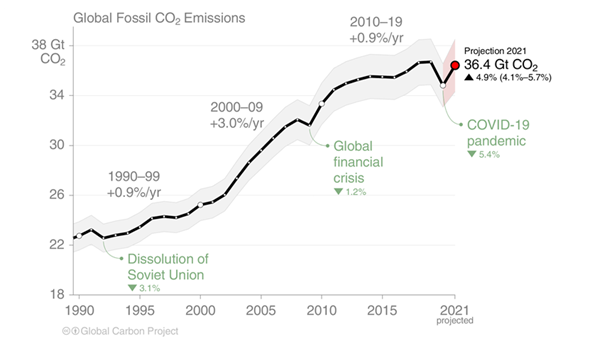The Sixth Assessment Report on climate change from the Intergovernmental Panel on Climate Change (IPCC), the third part of which was published earlier this month, has not been an easy read. Global CO2 emissions rose by +6% to 36.3bn tons in 2021, more than offsetting the reduction in 2020 due to Covid-19. The sustainable recovery much touted by governments has so far yet to come to fruition.

Source: Global Carbon Project, https://www.icos-cp.eu/science-and-impact/global-carbon-budget/2021
The first part of the IPCC report highlighted the acceleration of disruption to the planet, with the finding that the climate was changing more rapidly than scientists had expected. The second part was an analysis of the impacts of climate change to date, also finding that the consequences of climate change are worse than expected but outlining how humans and the natural world could adapt to these changes. The latest part deals with mitigation, and what we can do to limit the worsening of these impacts. It is important to remember that these reports are vast scientific projects, the work of 278 researchers over 7 years summarizing over 18’000 scientific publications. It is also even more important to remember that this is a watered-down document which went through over 40 hours of negotiation between representatives of the 195 UN members.
In summary, the report sets out a failure to date of the international community to tackle climate change: global emissions have risen by 14% since the Paris Agreement in 2015 in comparison to the commitment of member states to reduce emissions by 45% by 2030. These total figures may hide the major change and enormous efforts made in certain industries and in certain countries. But the aggregate view is that to have any chance of limiting the temperature rise to 1.5°C, GHG emissions need to peak globally in 2025 before reducing 43% by 2030. This gives us just three years to completely flatten the growth curve; the window to meet the Paris goals is closing.
As we well know, governmental action and regulation is by far the greatest tool to curb emissions, but this IPCC report once again should remind us that we do not have time to leave this to others to solve. At QUAERO CAPITAL, we are responding to this call to action across multiple areas, as outlined in our Annual Sustainability Report to be published later this month:
- In our infrastructure funds, we generated 692 GWh of clean energy across wind and hydro-electric assets in 2021, an increase of +53% since 2020.
- Our real estate funds are renovating buildings to improve energy efficiency, aiming for gold standard certifications
- When looking at our listed equity and fixed income investments, all but one of our funds has a lower carbon footprint than their benchmarks. Our Accessible Clean Energy fund, which finished 2021 with EUR136m of assets under management, was invested at that time in companies whose products sold during the year we estimate will avoid CO2 emissions of 671m tonnes over their lifetime, twice the annual emissions of France.
In addition, we will shortly be joining the Net Zero Asset Manager initiative and setting targets for the proportion of our investments which must set their own Science Based Targets, ensuring these companies align with the emission intensity accepted in a path to net zero by 2050. As investors we intend to play our part to engage and encourage companies to do their part in the fight against climate change.
We will continue to engage governments through investor collaborations, through organisations such as the Institutional Investor Group on Climate Change (IIGCC).
Operationally we have taken steps to reduce our carbon footprint, contracting 100% renewable energy at three out of four of our offices (with the fourth to follow), switching flights to trains where a direct journey is possible, reducing travel completely when it is not necessary and encouraging lower carbon commutes. The result is a reduction of 68% since 2019 to 36.9 tonnes of CO2, driven by both a change in commuting transport choices and a reduction in business travel. This partly reflects the impact of the pandemic so we do expect our footprint to increase in 2022 as the impacts of the pandemic subside, but we also expect many of the changes in behaviour to remain and our carbon footprint to remain below previous years.

